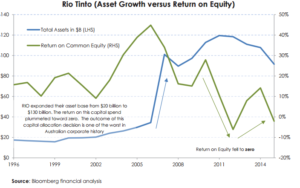The letter, which is available on company website outlines eight reasons for investment in resources
Newgate finds clear evidence of a synchronised recovery in the global economy at a time when there is genuine supply side restraint creating a perfect storm of rising prices
The current supply/demand environment is, a result of the commodity industry’s own mistakes. The resources boom, which took place between the early 2000s and 2014 was fuelled by China’s insatiable demand for commodities. However, commodity companies added new capacities at record high prices for industrial and bulk commodities pushing up input prices such as labor and materials to a point where capital costs of expansion were much greater than originally forecast. The world’s largest iron ore producer, Rio Tinto is a great example of this colossal value destruction. Newgate points out that between 2005 and 2015 Rio increased its asset base from $20 billion to $130 billion but over the same period return on equity collapsed from a high of 45% in 2005 to a low of -5% in 2012 and is currently around 0%.

“In very simple terms, one of the greatest resource booms in recorded economic history was squandered by the poor decisions made by the leadership of major global resource companies. They outlaid too much to expand supply, and when the increased production entered the market major price falls saw dreadful project economics.”
As commodity prices plunged and costs remain elevated, many small highly leveraged commodity companies were pushed into bankruptcy, and some of the world’s largest commodity trading houses such as Glencore and Noble were forced to issue new capital and deny accusations they were close to running out of cash.
To make our argument for an investment in resource companies we detail eight related justifications. 1. Economic outcome of the resources boom 2. Existential crisis of the resources industry 3. Psychological impact on leadership 4. Recovery period: value over volume 5. China capacity closures to protect the environment 6. Chinese fixed asset investment 7. Global growth is recovering strong 8. Animal spirit yet to emerge
Newgate points out that the commodity industry has now entered a new phase of capital preservation and risk aversion particularly in those companies which experienced a near death experience. It is the view of analysts at Newgate that resource company leadership are now a highly risk-averse group, and this will not change for the foreseeable future. They believe it could be up to a generation before resource companies embarked upon another round of value destroying capital expenditure, merger, and acquisitions.

“History will tell us that eventually resource companies will react to sustainably high prices by increasing supply. Nonetheless, because of the recent experience of resource company leadership we may be in a situation for many years where resource companies are content generating excessive cash flow and rewarding shareholders, rather than increasing supply.”
China is the wild card in resource markets. The country is a key producer of bulk commodities such as iron ore and coal, and many loss-making companies have been kept alive by cheap funding, allowing them to continue to produce even though traditional economics’ dictates they should collapse and take supply out the system. For the first time, China began to reform its commodity industry last year, closing excess supply to improve the overall health of the economy and reduce bad debts. Newgate expects this trend to continue over 2017 improving the supply-side picture. At the same time, the fund’s analysts believe the country’s consumption of bulk commodities will continue to grow at a steady rate for the foreseeable future.
Overall then, Newgate is highly optimistic about the outlook for commodity prices and commodity companies going forwards. Here is the concluding paragraph of Newgate’s January newsletter to sum up:
“Our conclusion is that the recent harsh lessons of the previous cycle means a supply response to high commodity prices may be very slow. This in turn may mean commodity prices remain elevated for longer than expected, allowing resource companies to enjoy heavy cashflows that can be paid out to shareholders over 2018 and 2019 and beyond.
Despite the excellent performance from resource companies over calendar year 2016, we still assess that it is a mildly contrarian investment. Many market participants are sceptical about current commodity pricing and are unwilling to invest in the sector, particularly after such strong performance over calendar year 2016.
We concede that some of our arguments may be wrong (in particularly Chinese demand and their fiscal position), and we will be tracking our thesis closely, but on the balance of probabilities, we believe it is time to be optimistic on global cyclical companies, particularly resources.”
I think if we add a mix of protectionism to Newgate’s arguments, it creates a potent mix of rising and volatile commodity prices which can have unintended consequence of rising inflation.